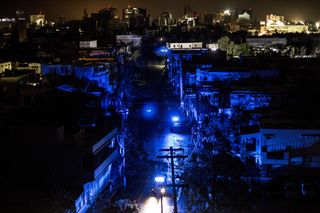
The Entire Island of Puerto Rico Just Lost Power Again — Here's Why

The entire island of Puerto Rico is without power again, according to the Associated Press, 210 days after its grid first collapsed during Hurricane Maria on Sept. 20, 2017.
The Puerto Rico Electric Power Authority (PREPA), the public utility company charged with serving the island, tweeted that it expects the current, island-wide blackout to last 24 to 36 hours, deepening the ongoing blackout that has already been the largest in U.S. history and the second-largest in the history of the world.
According to David Begnaud, who covers Puerto Rico for CBS News, a fault on a single line starting in the historic district of Aguirre Central, located in the southern part of the island, caused the blackout.
Such a complete blackout doesn't come out of nowhere. Though Gov. Ricardo Rosselló set a goal in October 2017 of having 95 percent of the island's power restored by December 2017, more than 16 percent of the U.S. territory remained entirely without power at the six-month anniversary of the storm in March, with regular blackouts continuing to strike areas where power had been restored.
As PBS has reported, with about 80 percent of Puerto Rico's electrical infrastructure destroyed in the storm; an electrical utility company accused of corruption and wastefulness; and an ongoing effort to privatize the utility, it's not entirely surprising that repairs have taken so long. As Vox pointed out in January, President Donald Trump and his administration have largely avoided drawing attention to the dire situation, which involved not just loss of power but also a breakdown in the delivery of other resources to the island. For instance, FEMA's contractor failed to deliver millions of meals before it stopped distributing emergency food and water entirely last year, Reuters reported.
The scale of the devastation on the island has been significant. As of December, more than 269,000 people had moved from Puerto Rico to Florida alone. Vox has reported on Puerto Rico's ongoing housing crisis, as well as a tripling in the number of Puerto Ricans trying to kill themselves. As Futurism reported, the official Hurricane Maria death count of 64 was likely wrong, with the actual count closer to 1,085. Today (April 18), CNN reported that many Puerto Rican patients must still travel hours for dialysis.
Originally published on Live Science.
Sign up for the Live Science daily newsletter now
Get the world’s most fascinating discoveries delivered straight to your inbox.

Most Popular


